|
Raw shadings of
what is believed to be a Computer Aided Design (CAD) model
of the new Lancia Delta have recently emerged across the
internet. They are believed to show the project at an early
design stage, and while the styling has reportedly somewhat
evolved from these CAD images, they do offer very useful
pointers as to the overall direction of this crucial
project.
These new CAD images and sketches have recently materialised together
with other details that are slowly emerging about Lancia’s crucial new
five-door hatchback. These
images are believed to be the first official depictions of
the car to break cover and, as expected, they illustrate
clear links to the well received 2003 Granturismo Stilnovo
concept; they also provide clear evidence that the new model
will be immediately distinguishable as a successor to the
highly-regarded Delta, a car which sold over 650,000 units in a life
spanning twenty years and two generations.
The nose of the
car takes clear inspiration from the 2003 Fulvia concept,
evolving the look from the independent grille of the present
models to an item which is flush with the headlamps similar
to the Nea concept car. Stylistically, this preserves yet
also evolves the traditional upright Lancia grille, whilst
also addressing the issue of pedestrian safety – a subject
which is rapidly increasing in importance and is taken
exceptionally seriously by Fiat Auto. Likewise, the
headlamps also bear a strong resemblance to that of the Fulvia, especially in the sharply
chiselled finish of the
lenses in the top third of the units.
Moving further
back, the fade-out at the trailing edge of the front
wheelarches is echoed by a similar fade-in at the front of
the rear arches. There is clear influence from the Ypsilon
bloodline in the drooping swage line which runs as a
continuous contour around the car and helps to give the car
a solid appearance originally inspired from the classic Aprilia model; this design feature, as well as the slightly
rising ridge running from front to rear light units
underneath the glasshouse, are reflective of the influence
of the Stilnovo concept in the new car’s birth. Another cue
from the Stilnovo is what Lancia calls “structural pillar
arches” – the windscreen pillars and top of the door frames,
which when combined with a GranLuce roof, will give the
effect of “a flying bridge soaring up into the air."
|
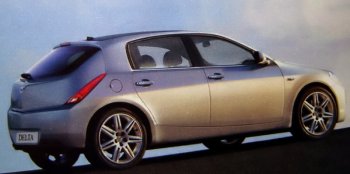 |
|
Italian magazine
Quattroroute has recently offered its own
interpretation of the forthcoming Lancia Delta, with
four conventional doors,
based on the recently leaked CAD drawings. Image:
Quattroruote. |
|

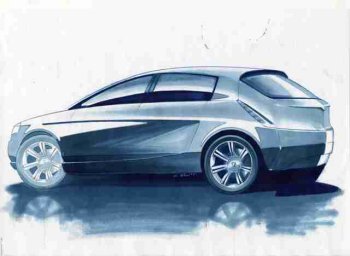 |
|
These images are believed to be the first official
depictions of the car to break cover and, as
expected, they illustrate clear links to the well
received 2003 Granturismo Stilnovo concept; they
also provide clear evidence that the new model will
be immediately distinguishable as a successor to the
Delta, a car which sold over 650,000 units in a life
spanning twenty years and two generations. |
|
|
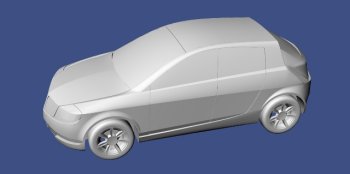
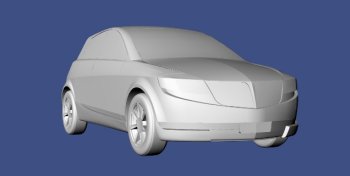
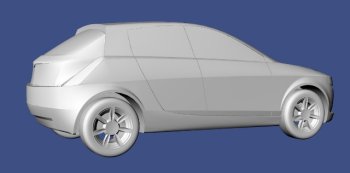
 |
|
Computer Aided Design stills, believed to show the
new Lancia Delta at an early stage have recently
emerged, as details begin to materialise about
Lancia’s crucial new hatchback. |
|
|
What is perhaps most interesting, though, is the suggestion
in the rear door shapes of a ‘suicide’ opening
mechanism. Lancia were initially planning to launch a 5-door
version of the current Ypsilon with suicide rear doors, but
this project was discontinued due to the overlap of the Musa
MPV model.
The tail represents perhaps the most distinctive part of the
car, with the almost-vertical C-pillars bearing more than a
passing resemblance to Renault’s bold Megane. Unlike the
Renault, however, the Delta sees Lancia’s trademark rear
lights flanking a rear screen with a fairly shallow rake. The tailgate tapers to a ridge running down the
centreline
of the car, echoing the crease running down the bonnet. There is a noticeable ‘step’ between the trailing edge of
the roof and the tailgate; this also appears, albeit less
conspicuously, on the sketch showing the rear three-quarter
view of the proposed design, so is highly likely to appear
in production, and will provide a distinctive sight for
fellow drivers.
Marginally
longer than the class average at slightly over 4.4m, the
extra length will be used to differentiate the new Delta from the Fiat
Group’s other players in the C-segment, the forthcoming Alfa
Romeo 149 and the new Fiat Stilo. In fact, even the Alfa
Romeo 149 will grow in size over the current 147, and will
measure 4.3m in order to bridge the hatchback in size
between the 147 and old 156. Despite this added length, it
is apparent that the Delta’s overhangs are not excessively
lengthy. This confirms that the Delta will have a longer
wheelbase than the Stilo successor, although it will ride on
the same (albeit much-modified) ‘Compact’ platform.
The large
dimensions for the class also serve another purpose. By
going for a cross-segment (C/D) approach, it is hoped that
the Delta will also provide a viable alternative for current Lybra owners who wish to stay with the
brand, or
prospective owners looking for that size of car. The
cross-segment size is imperative, as there is no direct
Lybra replacement currently planned. To be offered only as a
five-door and projected to sell between 30,000 and 40,000
units per year, the third-generation Delta will be the first
Lancia in over a decade to be offered with right-hand
drive. This is in preparation for a relaunch of the
brand into right-hook markets such as the UK, Japan and Oceania.
by Shant
Fabricatorian and James Granger
|
|
|
|
![]()
![]()